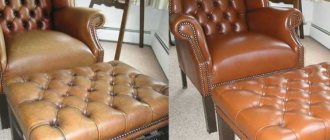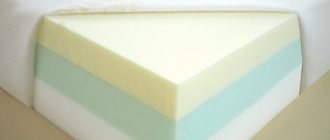Such an unpleasant little thing as stains appearing on the sofa can ruin your mood for a long time, but don’t panic, because they can be removed at home. Nowadays there is upholstered furniture in almost every home, so every housewife has at least once encountered the problem of stains. Not everyone can afford the services of cleaning companies. Therefore, let’s try to figure out how to get rid of various stains on the sofa yourself.
You can easily try to remove a fresh stain with warm water and two tablespoons of soda ash. For such cases, there should always be brushes in the house. A regular dishwashing sponge also works well to remove stains. Soda ash can be purchased at any hardware store at a low price, and its effectiveness is quite high.
For preventative purposes, it is better to regularly clean the surface of the sofa to avoid stains that are difficult to remove. Over time, they eat into the fabric and become much more difficult to remove. Therefore, it is better to start dealing with stains immediately after they appear.
General cleaning instructions
To clean a sofa from old stains or fresh ones, you need to study the general recommendations:
- Act quickly: freshly planted stains (up to 2 hours) are always removed easier and faster than stubborn ones.
- Work from the periphery to the central part so as not to smear the dirt even more and avoid streaks.
- Do not use aggressive cleaning agents such as solvent, chlorine bleach, etc.
- Test any store-bought or homemade furniture cleaning solution on an unseen part of the sofa.
- Use only clean, light-colored (preferably white) fabrics for upholstering the sofa.
- Cover the area around with film, especially if the upholstered furniture is on carpet.
- Sweep or vacuum the surface that has a lot of common debris - crumbs, wool. Use a blower to remove dust.
- Do not overdo it with water - excess moisture can damage not only the cover, but also the internal filling.
- Have the item dry cleaned or call a professional for stubborn stains or difficult-to-care materials (flock, leather, suede).
- Carefully read the instructions for caring for your particular fabric on the sofa upholstery - for example, velor cannot be vacuumed, flock is not treated with ethyl or ammonia, fur is cleaned exclusively by dry cleaning.
Cleaning leather furniture
To clean these luxurious interior items, you can only use a soft cloth or sponge.
Clean luxury leather furniture the right way, without risk
- White toothpaste works well, as does hairspray. Apply the product directly to the stain and then quickly remove it with a rag.
- The spray varnish effectively protects against ink and felt-tip pens.
- Ammonia and glycerin are only suitable for light skin. They will effectively remove ink marks. Apply the product to the stain, after a few minutes remove the remaining product with a damp cloth.
- Wipe the entire surface with milk to refresh the color and get rid of light stains.
- Starch, talc for greasy marks. Sprinkle the entire surface of the stain with one of the powders and leave overnight. In the morning, vacuum up the residue, wipe with a soapy sponge, and then with a cloth soaked in clean water.
- The blood is cleaned with a soap solution. Wipe the stain with a soapy sponge and then with a clean, damp one.
From time to time, rub homemade spray into dust-free leather furniture: mix 2 parts linseed (olive) oil and 1 part vinegar 9%, treat the upholstery. After 10 minutes, polish the entire surface with a soft microfiber cloth. Treatment with conditioner will protect leather furniture and refresh its appearance.
How to clean a leather sofa?
At first glance, leather seems to be the easiest material to care for - smooth, lint-free - you only need to occasionally brush off the dust. But it is the leather sofa that often becomes a victim of children’s artistic painting with a felt-tip pen or careless handling with a ballpoint pen.
One way or another, you can remove almost any stain from your skin at home. Let's talk about each separately:
- Ink, felt-tip pen. Fresh dirt can be removed without a trace with a cotton pad soaked in alcohol or cologne. Old drops or lines of bright color are a little less easy to erase, but alcohol should also help.
- Blood. These and other fresh stains can usually be cleaned with a regular damp cloth, so in what follows we will only consider stubborn stains. The blood is cleansed with acid - lemon juice, vinegar. Be sure to wipe in an inconspicuous area before starting to check for safety.
- Gum. The method is simple: put a few ice cubes on top, wait 5-10 minutes and carefully scrape off the frozen gum.
- Zelenka. Diamond green dye, even if just spilled, is almost impossible to clean up. If you are dealing with upholstered furniture made of painted leather, call a professional, because a suitable acetone or solvent will remove the stain along with the upholstery paint.
The photo shows the process of cleaning a leather sofa
Having contaminated the covering with something less durable, try to clean the sofa from stains using the most common kit: a soft rag, soap solution or Vaseline. If they don’t help, try purchasing special cleaning sprays or wet wipes for leather (even suitable for leather shoes or clothes).
Tip: To reduce the need to clean the leather, cover the sofa with a blanket or a nice sheet.
We’ve figured out the theory of cleaning a sofa made of natural or artificial leather, let’s move on to other types of material:
Suede leather. They don’t use natural upholstery, so you can be 99% sure that your suede is of artificial origin. If you are just planning to purchase a suede sofa, choose one that is treated with dirt-repellent impregnation - then any stains will be removed with a clean damp cloth.
Untreated material is more capricious: it cannot be rubbed too hard, wetted abundantly, or washed with aggressive agents. Maximum - soap solution, soft cloth, special brush with rubber bristles. After cleaning, it is advisable to treat the surface with a protective spray each time - it, of course, will not replace the factory coating, but it will also make cleaning easier in the future.
Nubuck. Less capricious than suede (for example, it is almost not afraid of water), but due to the lint on the surface it also does not tolerate rough handling. It is best to use dry cleaning, or use a special spray, foam, or wipes for nubuck.
Active foam works best - apply, wait the time indicated on the package, remove with a clean cloth - usually the dirt is simply absorbed into the foam and the sofa becomes cleaner.
Products that are not worth buying (useless cleaning products)
Not all advertised products do their job well.
Doesn't work well with stains:
- Nordland. Doesn't remove stains and leaves behind streaks. It has a harmful chemical composition and a pungent odor.
- Carpet. Doesn't cope well with problem areas and leaves behind a pungent odor.
- My family. It shows itself horribly even with the most minor dirt.
- Cinderella. The product is only suitable for frequent house cleaning. Doesn't work on old, stubborn stains.
The text discussed how and with what to wash a sofa from stains so that after treatment there are no stains left. For all types of pollution, the main rule is typical - the sooner treatment begins, the more effective the result will be.
How to remove stains from fabric upholstery?
Washing a sofa at home with a furniture fabric cover is also easy, especially if the material has been pre-treated with Easy Clean impregnation. In this case, any stain (even wine or blood) is wiped off with a damp cloth or sponge without detergents.
If the fabric material has not been impregnated, you will have to tinker with the stains. Each type of upholstery has its own recipe.
- Matting. The fabric itself is unpretentious, but aggressive chemistry can lead to fading, pilling, and rapid wear. The most universal composition for removing most stains is 1 tablespoon of fairy per 150-200 ml of warm water. After cleaning, it is forbidden to use heat drying (hair dryer, iron, radiator) - just open the windows and ensure natural air circulation.
In the photo, cleaning a sofa made of matting
- Velor, velvet. The longer the pile, the more carefully you need to choose methods. Any cleaning (dry and wet) is carried out strictly according to the pile, the wet one is carefully combed in the direction, and the area is allowed to dry naturally. You can use: microfiber, soft cotton, a weak solution of soap, powder or vinegar, a rubber brush. Avoid: hard bristles, abrasives, bleaches, solvents.
- Chenille. Water will ruin the fabric, so even the wet method of cleaning the sofa is different: rub the stain with a rag that has been wrung out as much as possible, then immediately go through it with a vacuum cleaner and dry it with a hairdryer.
- Flock. Unlike any other fabric, the pile here is glued, not woven. Therefore, any compositions that can dissolve glue are prohibited: alcohol, acetone, solvent, cologne. The most reliable way is to use special purchased products marked “for flocking”; in extreme cases, mix a weak soap solution.
The photo shows an example of flock texture
- Tapestry, jacquard. These durable, wear-resistant models are not afraid of almost anything, so choose a cleaner based on the type of stain: alcohol, soap, vinegar, soda, salt, fairy. Just in case, we recommend that you first test any solution in an inconspicuous place.
5 professional products for removing stains from the sofa
In some cases, treatment with folk remedies is not enough. Then they resort to liquids and powders that can be purchased in the store.
| Name | Features of application |
| "Vanish" (shampoo for upholstered furniture) | Vanisha foam removes greasy and complex stains |
| "Wedge" (spray) | Helps get rid of odors and light stains. |
| "Doctor Backman" (liquid for preparing solutions) | Effective in removing stains from rust, blood, grass, wine, grease. The result depends on the degree of concentration |
| "Antipyatin" (soap) | It works precisely. Rub the dirt with soap, leave it for a while, then wash it off |
| Amway (detergent) | Cleans cotton and loose fabrics. Helps get rid of small stains, eliminates odors |
Advice! After treatment with professional preparations, the room must be ventilated.
We remove different types of stains
The success of the result is influenced not only by the texture of the surface, but also by the origin of the stain. Each one is removed differently.
Fruit juice
At home, remove with an alcohol solution: 10 ml of ammonia per 1 liter of water. Apply, wait no more than 10-15 minutes, rinse with clean water.
Tea or black coffee
Make a solution or foam from laundry soap, apply, rinse after 15 minutes. If the stain still remains, you will need a vinegar solution: 2 tbsp per liter of water. 9% essence, diluted a little with soap, shampoo, dishwashing liquid. Wash and dry.
Wine
Freshly spilled salt is covered with fine salt, after which it is convenient to clean it with a vacuum cleaner.
Blood
Hydrogen peroxide will help effectively - but there is no need to rub, just blot, periodically changing the cotton pad to a clean one.
Chocolate
The first step is to freeze it - just put a few ice cubes on top. Frozen chocolate can be easily removed from the coating, and the remaining greasy stain will be removed by dishwashing detergent.
Dye
Watercolor is washed out with water, but gouache requires a special approach: do not use hot water, scrape off what has dried out, and carefully wash the remains with cold soapy water so that streaks do not appear.
Cosmetics
The most obvious option is micellar water; it dissolves the pollutant and makes it easier to wash out.
Fat
Soda and starch are excellent absorbents, cover them for a while and remove them with a vacuum cleaner. Residues should be washed off with dishwashing detergent.
The photo shows grease stains on the upholstery
Organic stains
As a rule, the results of the vital activity of pets are best removed with special commercial sprays. The unpleasant odor of urine is masked with a solution of vinegar or soda.
Cleaning fabric upholstery with vinegar and baking soda
You should dwell in more detail on such a popular method as removing stains with vinegar and soda. These substances are usually available at hand in any home.
Step 1. You need to prepare a cleaning composition. Five tbsp is diluted in 1/5 liter of purified filtered water. l. vinegar. After this, add a tablespoon of powder and the same amount of soda to the resulting liquid. The product foams strongly and should be prepared in a spacious container (bowl, basin).
Preparation of the cleaning composition
Step 2. When the liquid is inside the sprayer, it is immediately applied to be removed with a sponge or soft cloth. You need to act quickly while the composition is foaming and active. You don't have to wait long for it to dry or stop being absorbed.
A spray bottle is needed to apply the solution.
It should be remembered that the powder is not an essential component of the mixture, but it can complement it, give the product the desired aroma, etc.
Cleaning textiles will be simplified if you add lemon juice or peroxide to the mixture.
In no case should you, when sprinkling baking soda on the upholstery, pour vinegar solution on top of it. This will most likely lead to damage to the furniture covering, and the white spot may remain forever.
Sofas are also cleaned separately with vinegar and soda separately. General recommendations: to remove residual dirt, use vacuum cleaners with plastic collectors - fabric bags are not suitable for this purpose.
Remove wine stains with vinegar
Vinegar works great on blood and wine stains. It is enough to hold it in the form of a solution on the surface for 15 minutes. The characteristic smell disappears in 3-4 hours. You can speed up the process by using a vacuum cleaner, which will absorb not only the remaining dirt, but also unpleasant odors.
Vinegar with a high acid content is suitable for cleaning stains from furniture upholstery.
Recommendations for old stains
We have already mentioned that it is much easier to remove a fresh stain from any surface. But what to do if you see the pollution a day or even more later?
- Soak. Suitable for upholstery that is not afraid of water: wet the fabric with hot or warm water, place it on the stain, wait ~15 minutes.
- Use special cleaning products. A soap solution is not enough; purchase a spray or foam specifically for your type of material and stains.
- Trust a professional. If the old dirt cannot be removed the first time, there is no need to increase the power of the chemical used or the pressure on the brush during friction - it is better to call specialists. The work of a cleaning company will definitely cost less than buying a new sofa.
In the photo, cleaning the sofa with a washing vacuum cleaner
Finally, the main recommendation for cleaning sofas from all possible stains: didn’t it work the first time? Repeat the procedure. Didn't help with the second one? Contact the specialists!
Treatment of blood stains
Blood stains and marks are considered one of the most difficult to remove. A fresh stain is easier to remove, but sometimes you have to deal with old stains. There are several options for dealing with blood stains when plain water does not help remove them even in several steps:
- you need to prepare a salt solution from two teaspoons and a glass of water, which is then applied to the sofa with a spray bottle and immediately wiped with a dry cloth.
- if the stain is large and dry, apply pharmaceutical peroxide to the upholstery, then blot the area with a napkin and repeat until it stops bleeding;
- ammonia also works well with blood, but you need to be more careful with leather - such upholstery can be seriously damaged by ammonia.
It is better to clean the stain fresh











